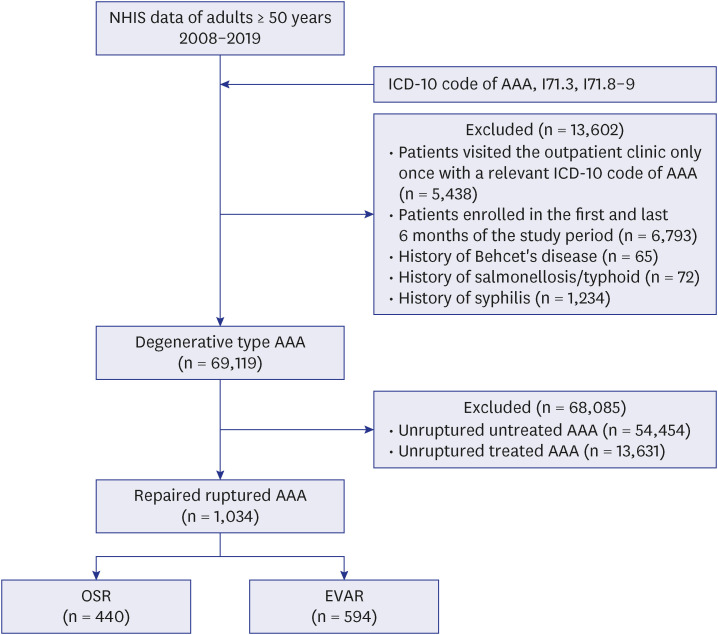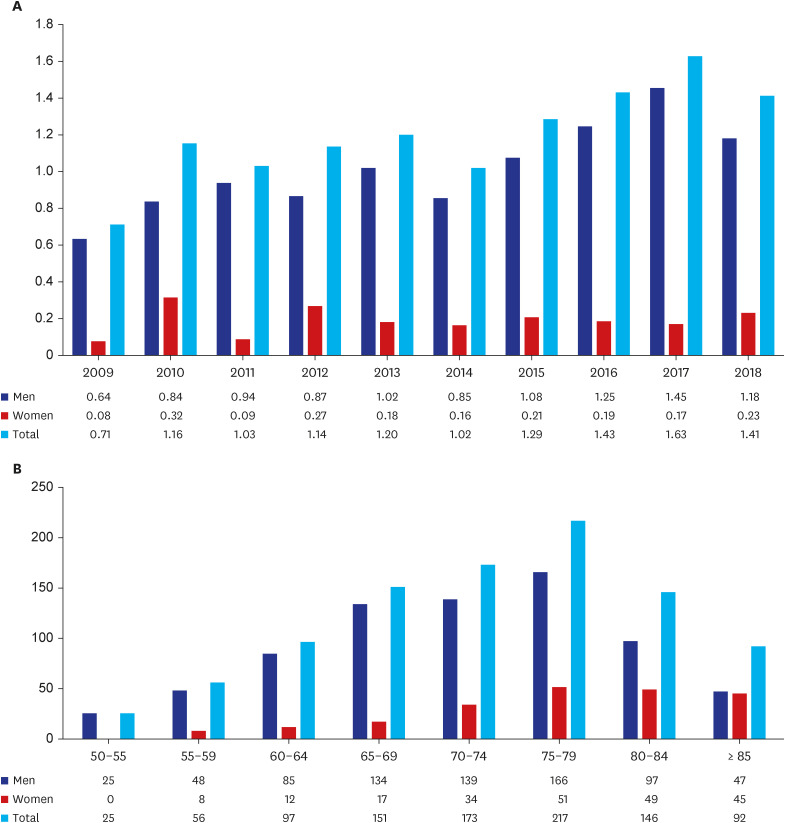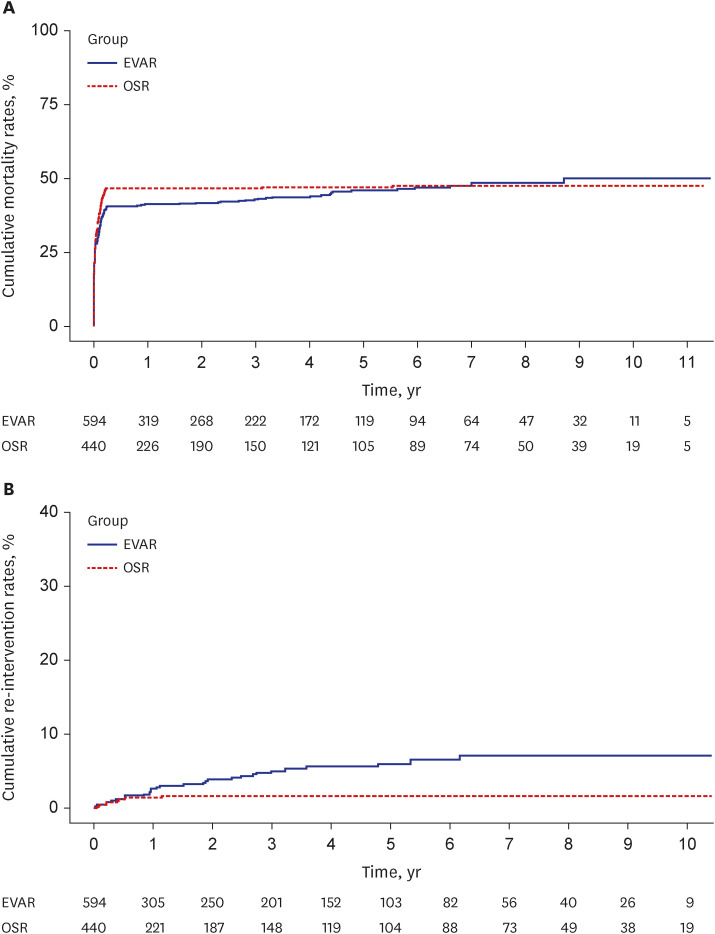J Korean Med Sci.
2023 Oct;38(39):e321. 10.3346/jkms.2023.38.e321.
Treatment Outcomes of Patients With Ruptured Abdominal Aortic Aneurysms
- Affiliations
-
- 1Department of Surgery, College of Medicine, Ewha Womans University, Seoul, Korea
- 2Division of Vascular Surgery, Department of Surgery, College of Medicine, University of Ulsan, Asan Medical Center, Seoul, Korea
- 3Department of Clinical Epidemiology and Biostatistics, Asan Medical Center, University of Ulsan College of Medicine, Seoul, Korea
- KMID: 2546923
- DOI: http://doi.org/10.3346/jkms.2023.38.e321
Abstract
- Background
Ruptured abdominal aortic aneurysm (rAAA) is a serious complication of abdominal aortic aneurysm associated with high operative mortality and morbidity rates. The present study evaluated the perioperative and long-term outcomes of Korean patients with rAAA based on national health insurance claims data.
Methods
The National Health Insurance Service (NHIS) database was searched retrospectively to identify patients with rAAA who underwent endovascular aneurysm repair (EVAR) and open surgical repair (OSR) from 2009 to 2018. Perioperative (≤ 30 days), early postoperative (≤ 3 month), and long-term (> 3 month) survival, reinterventions, and complications were assessed.
Results
The search identified 1,034 patients with rAAA, including 594 who underwent EVAR and 440 who underwent OSR. When the study period was divided into two, the total numbers of patients with rAAA, patients who underwent EVAR, and octogenarians were higher during the second half. The perioperative mortality rate was 29.8% in the EVAR and 35.0% in the OSR group (P = 0.028). Hartmann’s procedure for bowel infarction was performed more frequently in the OSR than in the EVAR group (adjusted odds ratio, 6.28; 95% confidence interval [CI], 2.33–21.84; P = 0.001), but other complication rates did not differ significantly. All-cause mortality during the entire observation period did not differ significantly in the EVAR and OSR groups (adjusted hazard ratio, 1.17; 95% CI, 0.98–1.41; P = 0.087). Abdominal aortic aneurysm-related reintervention rate was significantly lower in the OSR group (adjusted hazard ratio, 0.31; 95% CI, 0.14–0.70; P = 0.005).
Conclusion
Although EVAR showed somewhat superior perioperative outcomes for rAAA, the long-term outcomes of EVAR after excluding initial 3 months were significantly worse than OSR. When anatomically feasible for both treatments, the perioperative mortality risk and reasonable prospects of long-term survival should be considered in rAAA.
Keyword
Figure
Reference
-
1. Hurks R, Ultee KHJ, Buck DB, DaSilva GS, Soden PA, van Herwaarden JA, et al. The impact of endovascular repair on specialties performing abdominal aortic aneurysm repair. J Vasc Surg. 2015; 62(3):562–568.e3. PMID: 25953013.2. Chaikof EL, Dalman RL, Eskandari MK, Jackson BM, Lee WA, Mansour MA, et al. The Society for Vascular Surgery practice guidelines on the care of patients with an abdominal aortic aneurysm. J Vasc Surg. 2018; 67(1):2–77.e2. PMID: 29268916.3. Wanhainen A, Verzini F, Van Herzeele I, Allaire E, Bown M, Cohnert T, et al. Editor’s choice - European Society for Vascular Surgery (ESVS) 2019 clinical practice guidelines on the management of abdominal aorto-iliac artery aneurysms. Eur J Vasc Endovasc Surg. 2019; 57(1):8–93. PMID: 30528142.4. IMPROVE Trial Investigators. Comparative clinical effectiveness and cost effectiveness of endovascular strategy v open repair for ruptured abdominal aortic aneurysm: three year results of the IMPROVE randomised trial. BMJ. 2017; 359:j4859. PMID: 29138135.5. Edwards ST, Schermerhorn ML, O’Malley AJ, Bensley RP, Hurks R, Cotterill P, et al. Comparative effectiveness of endovascular versus open repair of ruptured abdominal aortic aneurysm in the Medicare population. J Vasc Surg. 2014; 59(3):575–582. PMID: 24342064.6. Gunnarsson K, Wanhainen A, Djavani Gidlund K, Björck M, Mani K. Endovascular versus open repair as primary strategy for ruptured abdominal aortic aneurysm: a national population-based study. Eur J Vasc Endovasc Surg. 2016; 51(1):22–28. PMID: 26238308.7. Sweeting MJ, Balm R, Desgranges P, Ulug P, Powell JT. Ruptured Aneurysm Trialists. Individual-patient meta-analysis of three randomized trials comparing endovascular versus open repair for ruptured abdominal aortic aneurysm. Br J Surg. 2015; 102(10):1229–1239. PMID: 26104471.8. Reimerink JJ, Hoornweg LL, Vahl AC, Wisselink W, van den Broek TA, Legemate DA, et al. Endovascular repair versus open repair of ruptured abdominal aortic aneurysms: a multicenter randomized controlled trial. Ann Surg. 2013; 258(2):248–256. PMID: 23549424.9. Desgranges P, Kobeiter H, Katsahian S, Bouffi M, Gouny P, Favre JP, et al. Editor’s choice - ECAR (Endovasculaire ou Chirurgie dans les Anévrysmes aorto-iliaques Rompus): a French randomized controlled trial of endovascular versus open surgical repair of ruptured aorto-iliac aneurysms. Eur J Vasc Endovasc Surg. 2015; 50(3):303–310. PMID: 26001320.10. IMPROVE Trial Investigators. Powell JT, Sweeting MJ, Thompson MM, Ashleigh R, Bell R, et al. Endovascular or open repair strategy for ruptured abdominal aortic aneurysm: 30 day outcomes from IMPROVE randomised trial. BMJ. 2014; 348:f7661. PMID: 24418950.11. Mohan PP, Hamblin MH. Comparison of endovascular and open repair of ruptured abdominal aortic aneurysm in the United States in the past decade. Cardiovasc Intervent Radiol. 2014; 37(2):337–342. PMID: 23756880.12. Mayer D, Aeschbacher S, Pfammatter T, Veith FJ, Norgren L, Magnuson A, et al. Complete replacement of open repair for ruptured abdominal aortic aneurysms by endovascular aneurysm repair: a two-center 14-year experience. Ann Surg. 2012; 256(5):688–695. PMID: 23095611.13. Lederle FA, Freischlag JA, Kyriakides TC, Padberg FT Jr, Matsumura JS, Kohler TR, et al. Outcomes following endovascular vs open repair of abdominal aortic aneurysm: a randomized trial. JAMA. 2009; 302(14):1535–1542. PMID: 19826022.14. United Kingdom EVAR Trial Investigators. Greenhalgh RM, Brown LC, Powell JT, Thompson SG, Epstein D. Endovascular repair of aortic aneurysm in patients physically ineligible for open repair. N Engl J Med. 2010; 362(20):1872–1880. PMID: 20382982.15. Salata K, Hussain MA, de Mestral C, Greco E, Awartani H, Aljabri BA, et al. Population-based long-term outcomes of open versus endovascular aortic repair of ruptured abdominal aortic aneurysms. J Vasc Surg. 2020; 71(6):1867–1878.e8. PMID: 32085959.16. Acher C, Acher CW, Castello Ramirez MC, Wynn M. Operative mortality and morbidity in ruptured abdominal aortic aneurysms in the endovascular age. Ann Vasc Surg. 2020; 66:70–76. PMID: 31676380.17. Ali MM, Flahive J, Schanzer A, Simons JP, Aiello FA, Doucet DR, et al. In patients stratified by preoperative risk, endovascular repair of ruptured abdominal aortic aneurysms has a lower in-hospital mortality and morbidity than open repair. J Vasc Surg. 2015; 61(6):1399–1407. PMID: 25752694.18. D’Oria M, Hanson KT, Shermerhorn M, Bower TC, Mendes BC, Shuja F, et al. Editor’s choice - Short term and long term outcomes after endovascular or open repair for ruptured infrarenal abdominal aortic aneurysms in the vascular quality initiative. Eur J Vasc Endovasc Surg. 2020; 59(5):703–716. PMID: 31948912.19. Antoniou GA, Antoniou SA, Torella F. Editor’s choice - Endovascular vs. open repair for abdominal aortic aneurysm: systematic review and meta-analysis of updated peri-operative and long term data of randomised controlled trials. Eur J Vasc Endovasc Surg. 2020; 59(3):385–397. PMID: 31899100.20. Ultee KH, Zettervall SL, Soden PA, Darling J, Bertges DJ, Verhagen HJ, et al. Incidence of and risk factors for bowel ischemia after abdominal aortic aneurysm repair. J Vasc Surg. 2016; 64(5):1384–1391. PMID: 27475466.21. Martinelli O, Fenelli C, Ben-Hamida JB, Fresilli M, Irace FG, Picone V, et al. One-year outcomes after ruptured abdominal aortic aneurysms repair: is endovascular aortic repair the best choice? a single-center experience. Ann Vasc Surg. 2018; 53:63–69. PMID: 29885434.22. Dias-Neto M, Castro-Ferreira R, Mani K, Freitas A, Leite-Moreira A, Sampaio SM. Nationwide analysis of ruptured abdominal aortic aneurysm in Portugal (2000-2015). Eur J Vasc Endovasc Surg. 2020; 60(1):27–35. PMID: 32307303.23. Wanhainen A, Hultgren R, Linné A, Holst J, Gottsäter A, Langenskiöld M, et al. Outcome of the Swedish Nationwide Abdominal Aortic Aneurysm Screening Program. Circulation. 2016; 134(16):1141–1148. PMID: 27630132.24. Glover MJ, Kim LG, Sweeting MJ, Thompson SG, Buxton MJ. Cost-effectiveness of the National Health Service Abdominal Aortic Aneurysm Screening Programme in England. Br J Surg. 2014; 101(8):976–982. PMID: 24862963.25. Guirguis-Blake JM, Beil TL, Senger CA, Coppola EL. Primary care screening for abdominal aortic aneurysm: updated evidence report and systematic review for the US Preventive Services Task Force. JAMA. 2019; 322(22):2219–2238. PMID: 31821436.
- Full Text Links
- Actions
-
Cited
- CITED
-
- Close
- Share
- Similar articles
-
- General Considerations of Ruptured Abdominal Aortic Aneurysm: Ruptured Abdominal Aortic Aneurysm
- Clinical Outcomes of Atypical Inflammatory Variants of Abdominal Aortic Aneurysm
- Abdominal Aortic Aneurysm
- Clinical Results of Abdominal Aortic Aneurysm from the Preoperative States
- The Risk Factors Influencing the Postoperative Mortality of the Patients with an Abdominal Aortic Aneurysm






